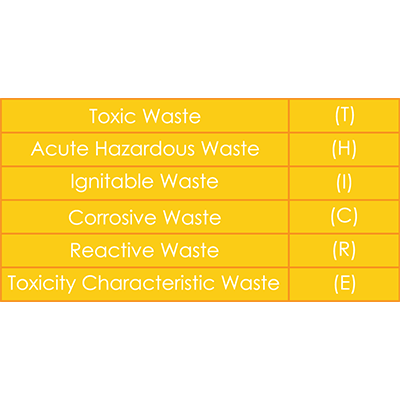
If we look back into the annals of EPA history before ever listing any hazardous wastes we will see that in the beginning the Agency had to develop the criteria that would serve as a guide for deciding whether or not a waste should be listed. These criteria are not used by hazardous waste handlers but rather serve as a frame of reference for the EPA when they are deciding whether a specific waste stream is eligible for listing. The lists decided upon and created by the EPA are then utilized by hazardous waste handlers for hazardous waste identification.
There are four different criteria the EPA utilizes as a basis for deciding whether or not to list a waste as hazardous. And while it may seem like they would correspond to the four different lists wastes can be split into, they are not directly related. According to the EPA the four criteria are:
- “The waste typically contains harmful chemicals, and other factors indicate that it could pose a threat to human health and the environment in the absence of special regulation. Such wastes are known as toxic listed wastes.
- The waste contains such dangerous chemicals that it could pose a threat to human health and the environment even when properly managed. Such wastes are known as acutely hazardous wastes.
- The waste typically exhibits one of the four characteristics of hazardous waste described in the hazardous waste identification regulations (ignitability, corrosivity, reactivity, or toxicity).
- When EPA has to cause to believe for some other reason, the waste typically fits within the statutory definition of hazardous waste developed by Congress.”
The EPA can decide to list a waste as hazardous for any and all of those four reasons. The majority of listed wastes, however, fall into the toxic waste category. According to the EPA, “to decide if a waste should be a toxic listed waste, EPA first determines whether it typically contains harmful chemical constituents. Appendix VIII of Part 261 contains a list of chemical compounds or elements which scientific studies show to have toxic, carcinogenic, mutagenic, or teratogenic effects on humans or other life forms. If a waste contains chemical constituents found on the Appendix VIII list, EPA then evaluates 11 other factors to determine if the waste stream is likely to pose a threat in the absence of special restrictions on its handling. These additional considerations include a risk assessment and study of past cases of damage caused by the waste.”
The second most common reason for a waste stream to be listed it that it is an acutely hazardous waste. The EPA designates those materials which contain constituents found in Appendix VIII, which are fatal to humans or animals in small doses, as acutely hazardous.
In order to indicate why a waste was listed as it was the EPA assigns a hazard code to each waste listed on the F, K, P, or U lists. These codes are:
The different codes assigned to wastes affect the regulations that apply to handling them. Acutely hazardous wastes (H) for example are subject to stricter management standards than most other wastes.
All information for this blog post was gathered from the EPA document, “Introduction to Hazardous Waste Identification.” As always, this blog post is not intended to be comprehensive and it is always best to check with the EPA and local government for full, up-to-date, rules and regulations.
More News From Heritage
-
12/23/24
Wreaths Across America 2024
This year, through collective effort and heartfelt generosity, we sponsored 727 wreaths and transported two truckloads of wreaths across the country.
-
12/2/24
Heritage Environmental Services Announces Rachel Evans as Chief Human Resources Officer
Heritage Environmental Services announced today that Rachel Evans will join the organization as Chief Human Resources Officer.
-
11/26/24
Honoring Teresa Wade: A Legacy of Dedication to Wreaths Across America
Celebrate Teresa Wade's legacy at Heritage Environmental and her dedication to Wreaths Across America. Learn her story and how you can honor veterans
-
11/14/24
Bright Futures Begin Lead-Free: Reducing Lead Exposure Together
Learn about lead decontamination, disposal processes, and join us in creating a lead-free future.
-
11/11/24
Celebrating Our Veterans at Heritage Environmental Services
-
10/31/24
Heritage Environmental Services Secures Commercial Permit Status for Orange, TX Incinerator
Learn more about Heritage Environmental Services securing a commercial permit for its Orange, TX incinerator, expanding waste disposal solutions.
-
10/14/24
Heritage Environmental Services Announces Timothy Thomas as Chief Operating Officer
Heritage Environmental Services (“HES”), an EQT Infrastructure portfolio company, announced today that Timothy Thomas will join the organization as Ch
-
10/1/24
Heritage Environmental Services Complete Acquisition of EBV from General Dynamics
Heritage Environmental Services, an EQT Infrastructure portfolio company, has completed the acquisition of EBV from General Dynamics.








